Ecological Quality Evolution and Its Driving Factors in Yunnan Karst Rocky Desertification Areas
Abstract
1. Introduction
2. Materials and Methods
2.1. Study Area
2.2. Data Source
2.3. Indicator Extraction
2.3.1. Rocky Desertification Information Extraction
2.3.2. Ecological Quality Information Extraction
2.4. Spatiotemporal Analysis Model
2.4.1. Trend Analysis
2.4.2. Redundancy Analysis
3. Results
3.1. Evolution Characteristics of Ecological Quality in Yunnan Karst Rocky Desertification Areas
3.1.1. The Overall Evolution Characteristics of Ecological Quality
3.1.2. Spatiotemporal Variation in Ecological Quality Characteristics
3.1.3. Hierarchical Change Characteristics of Ecological Quality
3.2. Evolution Characteristics of Rocky Desertification Degree in Yunnan Karst Rocky Desertification Areas
3.2.1. The Overall Evolution Characteristics of Rocky Desertification Degree
3.2.2. Spatiotemporal Variation in Rocky Desertification Degree
3.2.3. Hierarchical Change Characteristics of Rocky Desertification Degree
3.3. Correlation between Ecological Quality Evolution and Driving Factors
3.3.1. Correlation Analysis with Modeling Factors
3.3.2. Correlation between Ecological Quality and Topographic and Soil Factors
3.3.3. Correlation of Ecological Quality with Water and Anthropogenic Factors
4. Discussion
4.1. Ecological Quality Evolution in Karst Rocky Desertification Areas and Its Causes
4.2. Correlation between Ecological Quality and Driving Factors in Karst Rocky Desertification Areas
5. Conclusions
Author Contributions
Funding
Institutional Review Board Statement
Informed Consent Statement
Data Availability Statement
Acknowledgments
Conflicts of Interest
References
- Goldscheider, N.; Chen, Z.; Auler, A.S.; Bakalowicz, M.; Broda, S.; Drew, D.; Hartmann, J.; Jiang, G.H.; Moosdorf, N.; Stevanovic, Z.; et al. Global Distribution of Carbonate Rocks and Karst Water Resources. Hydrogeol. J. 2020, 28, 1661–1677. [Google Scholar] [CrossRef]
- Williams, P. World Heritage Caves and Karst; IUCN: Gland, Switzerland, 2008; p. 57. [Google Scholar]
- Ford, D.; Williams, P.D. Karst Hydrogeology and Geomorphology; John Wiley & Sons: Hoboken, NJ, USA, 2007. [Google Scholar]
- Sweeting, M.M. Reflections on the Development of Karst Geomorphology in Europe and a Comparison with its Development in China. Z. Geomorph. 1993, 37, 127–138. [Google Scholar]
- Tong, X.W.; Brandt, M.; Yue, Y.M.; Horion, S.; Wang, K.L.; Keersmaecker, W.D.; Tian, F.; Schurgers, G.; Xiao, X.M.; Luo, Y.Q.; et al. Increased Vegetation Growth and Carbon Stock in China Karst Via Ecological Engineering. Nat. Sustain. 2018, 1, 44–50. [Google Scholar] [CrossRef]
- Yang, Q.Q.; Wang, K.L.; Zhang, C.H.; Yue, Y.M.; Tian, R.C.; Tian, R.C.; Fan, F.D. Spatio-temporal Evolution of Rocky Desertification and its Driving Forces in Karst Areas of Northwestern Guangxi, China. Environ. Earth Sci. 2010, 64, 383–393. [Google Scholar] [CrossRef]
- National Forestry and Grassland Administration. China Karst Rocky Desertification Bulletin (2018). Available online: http://www.forestry.gov.cn/main/3457/20181214/161611806917453.html (accessed on 10 September 2022).
- Wang, S.J.; Li, R.L.; Sun, C.X.; Zhang, D.F.; Li, F.Q.; Zhou, D.Q.; Xiong, K.N.; Zhou, Z.F. How Types of Carbonate Rock Assemblages Constrain the Distribution of Karst Rocky Desertified Land in Guizhou Province, PR China: Phenomena and Mechanisms. Land Degrad. Dev. 2004, 15, 123–131. [Google Scholar] [CrossRef]
- Jiang, M.; Lin, Y.; Chan, T.O.; Yao, Y.J.; Zheng, G.; Luo, S.Z.; Zhang, L.; Liu, D.P. Geologic Factors Leadingly Drawing the Macroecological Pattern of Rocky Desertification in Southwest China. Sci. Rep. 2020, 10, 1440. [Google Scholar] [CrossRef]
- Wang, S.J.; Liu, Q.M.; Zhang, D.F. Karst Rocky Desertification in Southwestern China: Geomorphology, Land Use, Impact and Rehabilitation. Land Degrad. Dev. 2004, 15, 115–121. [Google Scholar] [CrossRef]
- Wu, X.Q.; Liu, H.M.; Huang, X.L.; Zhou, T. Human Driving Forces: Analysis of Rocky Desertification in Karst Region in Guanling County, Guizhou Province. Chin. Geogr. Sci. 2011, 21, 600–608. [Google Scholar] [CrossRef]
- Xu, E.Q.; Zhang, H.Q.; Li, M.X. Mining Spatial Information to Investigate the Evolution of Karst Rocky Desertification and its Human Driving Forces in Changshun, China. Sci. Total Environ. 2013, 458–460, 419–426. [Google Scholar] [CrossRef]
- Glantz, M.H.; Orlovsky, N.S. Desertification: A Review of Concept. Desertif. Control. Bull. 1983, 9, 15–22. [Google Scholar]
- Yuan, D.X. On the Environmental and Geologic Problems of Karst Mountains and Rocky in the Southwest China. World Sci-Tech R & D 1997, 19, 41–43. [Google Scholar]
- Huang, X.F.; Zhou, Y.C.; Wang, S.J.; Zhang, Z.M. Occurrence Mechanism and Prediction of Rocky Land Degradation in Karst Mountainous Basins with the Aid of GIS Technology, a Study Case in Houzhai River Basin in Southwestern China. Environ. Earth Sci. 2019, 78, 217. [Google Scholar] [CrossRef]
- Luo, X.L.; Wang, S.J.; Bai, X.Y.; Tan, Q.; Ran, C.; Chen, H.; Xi, H.P.; Chen, F.; Cao, Y.; Wu, L.H.; et al. Analysis on the Spatio-temporal Evolution Process of Rocky Desertification in Southwest Karst Area. Acta Ecol. Sin. 2021, 41, 680–693. [Google Scholar]
- Bai, X.Y.; Wang, S.J.; Xiong, K.N. Assessment Spatial-temporal Evolution Processes of Karst Rocky Desertification Land: Indications for Restoration Strategies. Land Degrad. Dev. 2011, 24, 47–56. [Google Scholar] [CrossRef]
- Yu, M.; Li, Y.B.; Luo, G.J. Evolution Tendency of Rocky Desertification in Karst Mountainous Areas of Southwest China. Acta Ecol. Sin. 2022, 42, 4267–4283. [Google Scholar]
- Du, W.P.; Yan, H.M.; Zhen, L.; Hu, Y.F. The Experience and Practice of Desertification Control in Karst Region of Southwest China. Acta Ecol. Sin. 2019, 39, 5798–5808. [Google Scholar]
- Zhang, X.L. Research on Integrated Application Technology of Remote Sensing Monitoring of Rocky Desertification in Southeast Yunnan. Master’s Thesis, Kunming University of Science and Technology, Kunming, China, 2013. [Google Scholar]
- Xu, H.F.; Wang, Y.; Su, Q.; Li, Z.; Jia, Y.J. Evolution of Rocky Desertification and Driving Factors in Typical Karst Areas of Yunnan Province. J. Arid. Land Resour. Environ. 2022, 36, 94–101. [Google Scholar]
- Chen, F.; Wang, S.J.; Bai, X.Y.; Liu, F.; Tian, Y.C.; Luo, G.J.; Li, Q.; Wang, J.F.; Wu, L.H.; Cao, Y.; et al. Spatio-temporal Evolution and Future Scenario Prediction of Karst Rocky Desertification based on CA-Markov Model. Arab. J. Geosci. 2021, 14, 1262. [Google Scholar] [CrossRef]
- Xu, E.Q.; Zhang, H.Q. A Spatial Simulation Model for Karst Rocky Desertification Combining Top-down and Bottom-up Approaches. Land Degrad. Dev. 2018, 29, 3390–3404. [Google Scholar] [CrossRef]
- Deng, Y.; Cao, J.H.; Jiang, Z.C.; Zhou, X.D.; Yue, X.F. Advancement in Key Technologies for Comprehensive Treatment of Water, Soil and Vegetation Resources in Karst Rocky Desertification Areas. Carsologica Sin. 2016, 35, 476–485. [Google Scholar]
- Xiong, J.N.; Peng, C.; Cheng, W.M.; Li, W.; Liu, Z.Q.; Fan, C.K.; Sun, H.Z. Analysis of Vegetation Coverage Change in Yunnan Province based on MODIS-NDVI. J. Geo-Inf. Sci. 2018, 20, 1830–1840. [Google Scholar]
- Nong, L.P.; Wang, J.L. Dynamic Monitoring of Ecological Environment Quality in Kunming Based on RSEI Model. Chin. J. Ecol. 2020, 39, 2042–2050. [Google Scholar]
- Nong, L.P.; Wang, J.L.; Yu, Y.H. Research on Ecological Environment Quality in Central Yunnan Based on MRSEI Model. J. Ecol. Rural. Environ. 2021, 37, 972–982. [Google Scholar]
- Wu, Z.B.; Dan, X.Q.; Wu, X.B.; Liu, S.H.; Liu, W.; Ning, X.B. China Karst Rocky Desertification; China Forestry Publishing House: Beijing, China, 2020; pp. 5–6. [Google Scholar]
- Hengl, T.; MacMillan, R.A. Predictive Soil Mapping with R; Lulu Press: Morrisville, NC, USA, 2019. [Google Scholar]
- Pelletier, J.D.; Broxton, P.D.; Hazenberg, P.; Zeng, X.B.; Troch, P.A.; Niu, G.Y.; Williams, Z.; Brunke, M.A.; Gochis, D. A Gridded Global Data Set of Soil, Intact Regolith, and Sedimentary Deposit Thicknesses for Regional and Global Land Surface Modeling. J. Adv. Model. Earth Syst. 2016, 8, 41–65. [Google Scholar] [CrossRef]
- Zhang, X.; Liu, L.Y.; Zhao, T.T.; Gao, Y.; Chen, X.D.; Mi, J. GISD30: Global 30 m Impervious-surface Dynamic Dataset from 1985 to 2020 Using Time-series Landsat Imagery on the Google Earth Engine Platform. Earth Syst. Sci. Data 2022, 14, 1831–1856. [Google Scholar] [CrossRef]
- Li, N.; Wang, J.Y.; Qin, F. The Improvement of Ecological Environment Index Model RSEI. Arab. J. Geosci. 2020, 13, 403. [Google Scholar]
- Xu, H.Q.; Wang, Y.F.; Guan, H.D.; Shi, T.T.; Hu, X.S. Detecting Ecological Changes with a Remote Sensing Based Ecological Index (RSEI) Produced Time Series and Change Vector Analysis. Remote Sens. 2019, 11, 2345. [Google Scholar] [CrossRef]
- Wang, J.L.; Li, W.J.; Wang, Y.; Ren, J.; Gao, M. Spatial-temporal Variation of NDVI and its Responses to Hydrothermal Conditions in Rocky Desertification Area of Chongqing City from 2005 to 2014. Res. Soil Water Conserv. 2021, 28, 217–223. [Google Scholar]
- Lai, J.S. Canoco 5: A New Version of an Ecological Multivariate Data Ordination Program. Biodivers. Sci. 2013, 21, 765–768. [Google Scholar]
- Wu, N.; Li, S.C.; Ren, X.D.; Wu, Z.B. Yunnan Rocky Desertification; China Forestry Publishing House: Beijing, China, 2020; pp. 25–42, 78–84. [Google Scholar]
- Geng, H. Water Resources Development and Utilization in Yunnan Karst Regions; Yunnan Science and Technology Press: Kunming, China, 2002; p. 85. [Google Scholar]
- Kereselidze, D.N.; Machavariani, L.G.; Kalandadze, B.B.; Trapaidze, V.Z. Allowable Soil Erosion Rates in Georgia. Eurasian Soil Sci. 2013, 46, 438–446. [Google Scholar] [CrossRef]
- Chen, Q. Models and Technologies for Ecological Management of Rocky Desertification in Yunnan Karst Regions; Yunnan Science and Technology Press: Kunming, China, 2010; pp. 16–22. [Google Scholar]
- Cao, J.H.; Deng, Y.; Yang, H.; Pu, J.B.; Zhu, T.B.; Lan, F.N.; Huang, F.; Li, J.H. Rocky Desertification Evolution, Treatment Technology and Demonstration in Karst Faulted Basins, Southwest China. Acta Ecol. Sin. 2016, 36, 7103–7108. [Google Scholar]
- Yuan, D.X. Scientific Innovation in Karst Resources and Environment Research Field of China. Carsologica Sin. 2015, 34, 98–100. [Google Scholar]
- Zhao, C.E.; Ding, W.R. Dynamic Analysis of Ecological Footprint During 2000–2010 of Kunming City. China Population. Resour. Environ. 2013, 23, 99–102. [Google Scholar]
- National Forestry and Grassland Administration. China Rocky Desertification Bulletin (2012). Available online: http://www.forestry.gov.cn/ (accessed on 10 September 2022).
- Qi, X.K.; Wang, K.L.; Zhang, C.H. Effectiveness of Ecological Restoration Projects in a Karst Region of Southwest China Assessed Using Vegetation Succession Mapping. Ecol. Eng. 2013, 54, 245–253. [Google Scholar] [CrossRef]
- Chen, C.J.; Yuan, D.X.; Cheng, H.; Yu, L.T.; Shen, C.C.; Edwards, R.L.; Wu, Y.; Xiao, S.Y.; Zhang, J.; Wang, T.; et al. Human Activity and Climate Change Triggered the Expansion of Rocky Desertification in the Karst Areas of Southwestern China. Sci. China Earth Sci. 2021, 64, 1761–1773. [Google Scholar] [CrossRef]
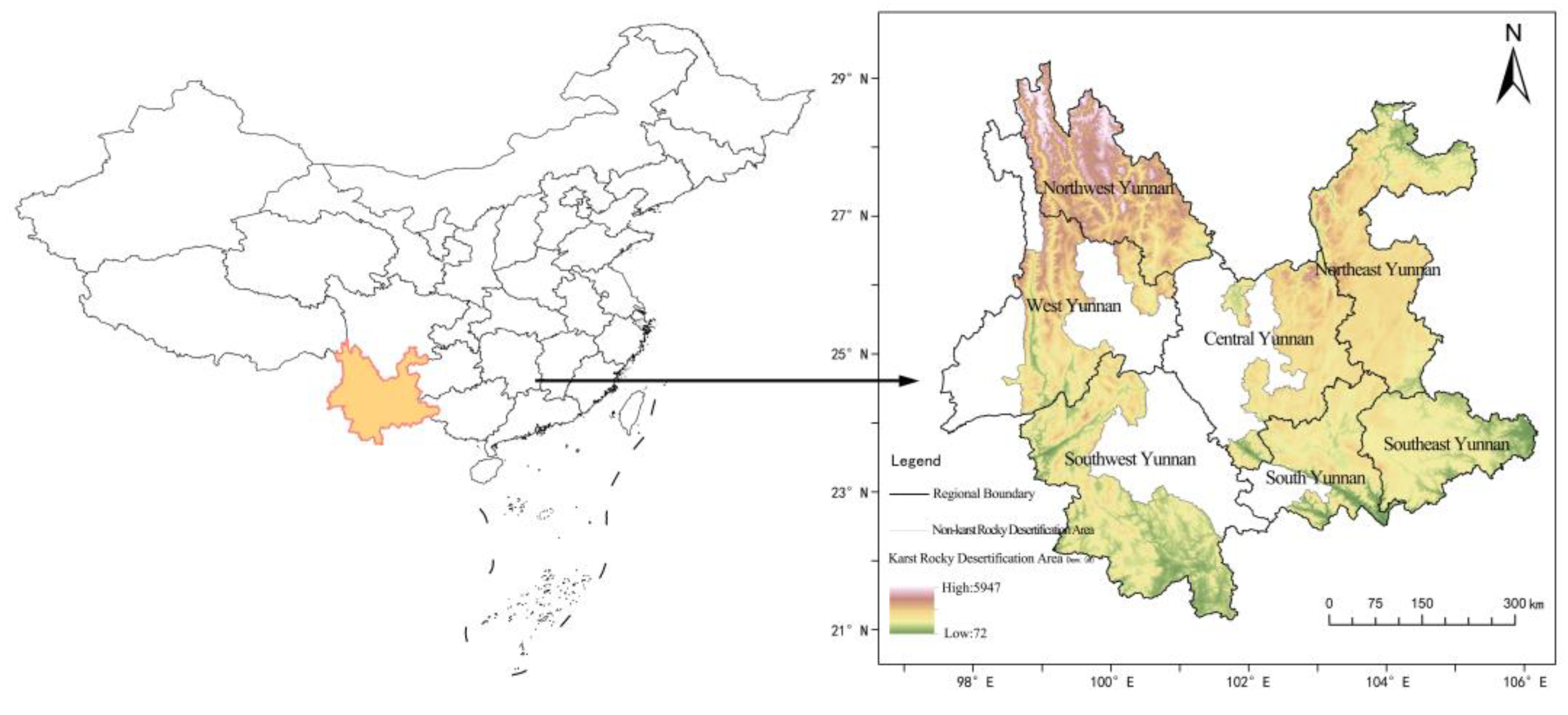

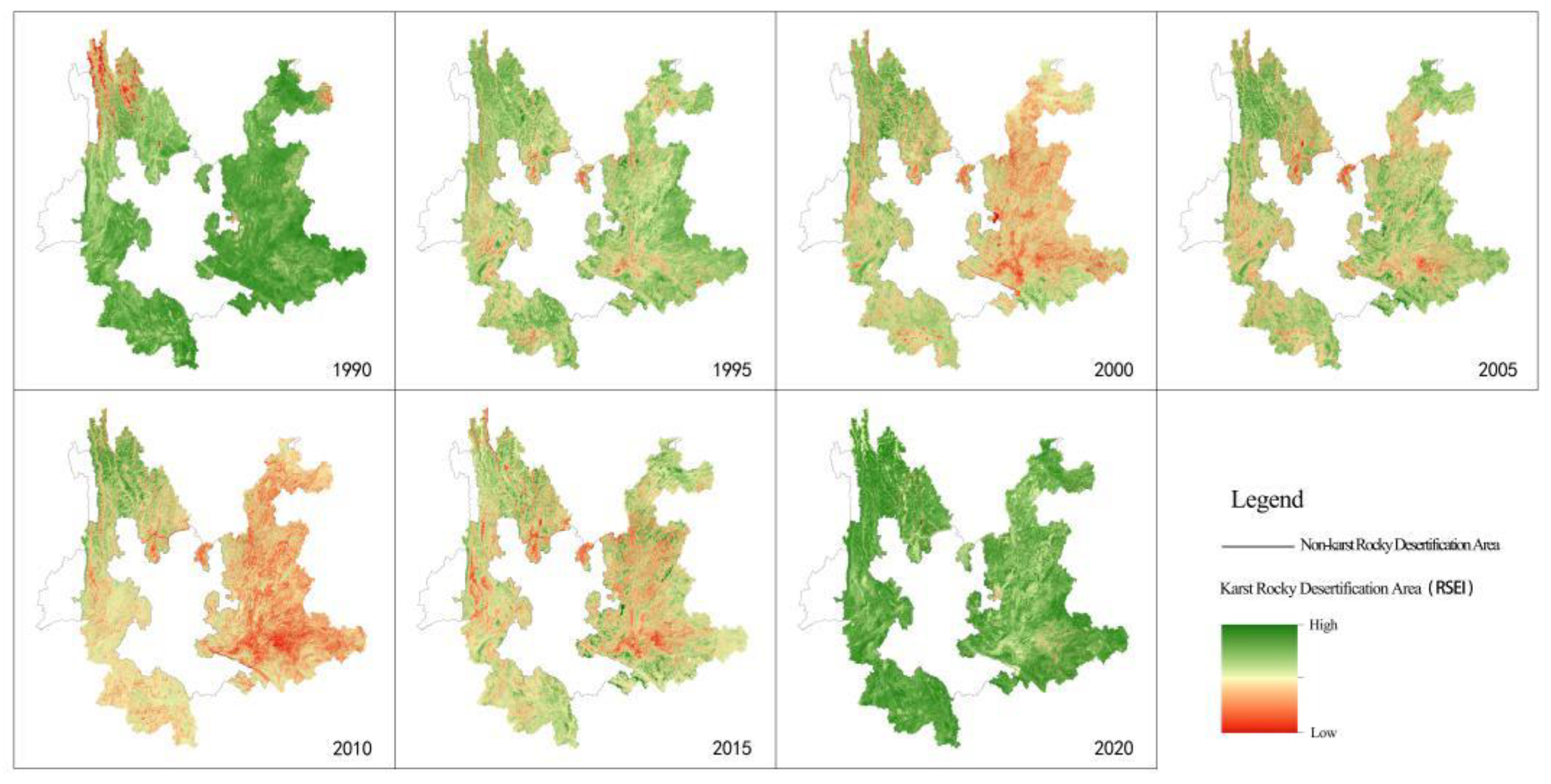
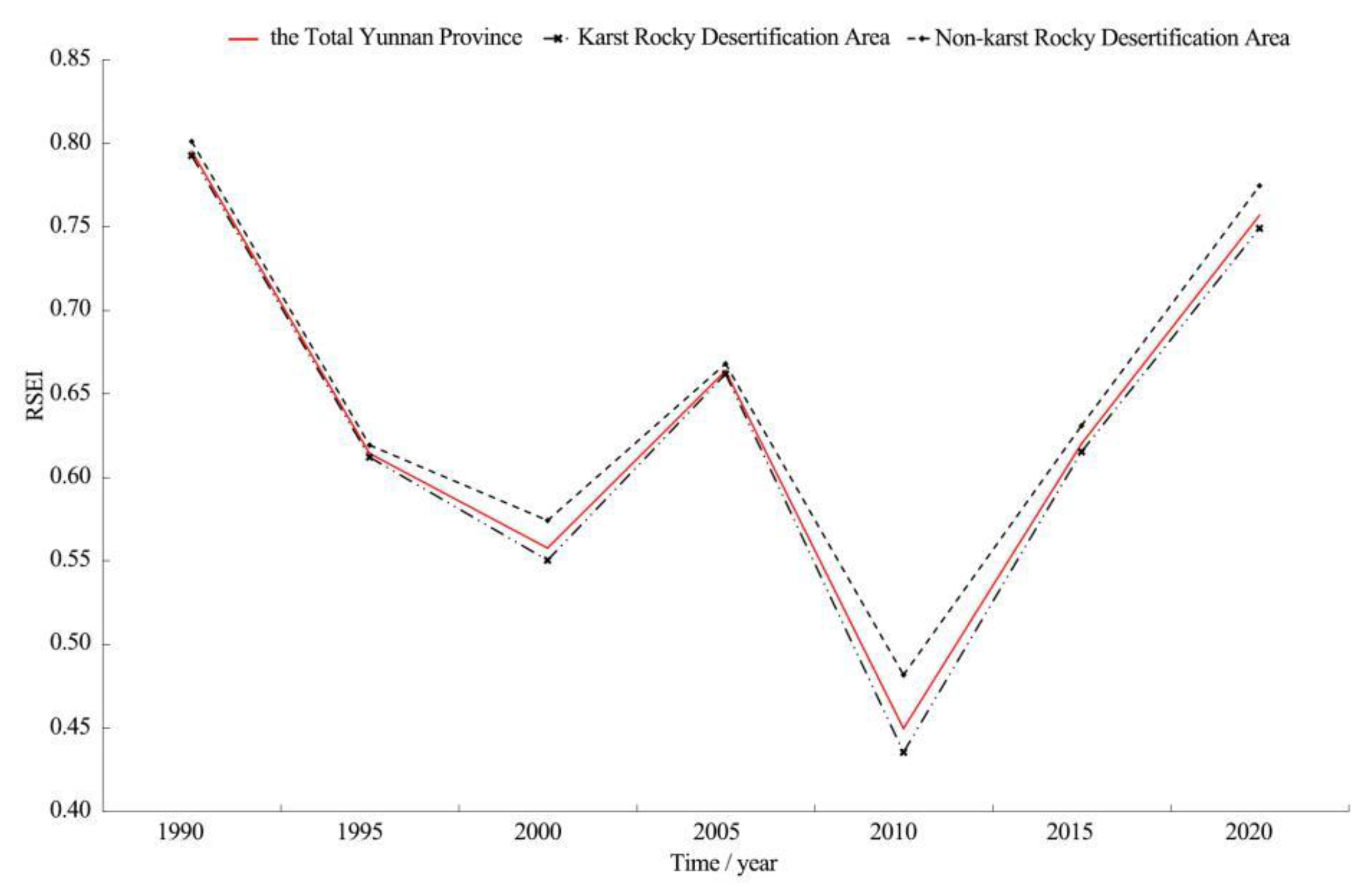

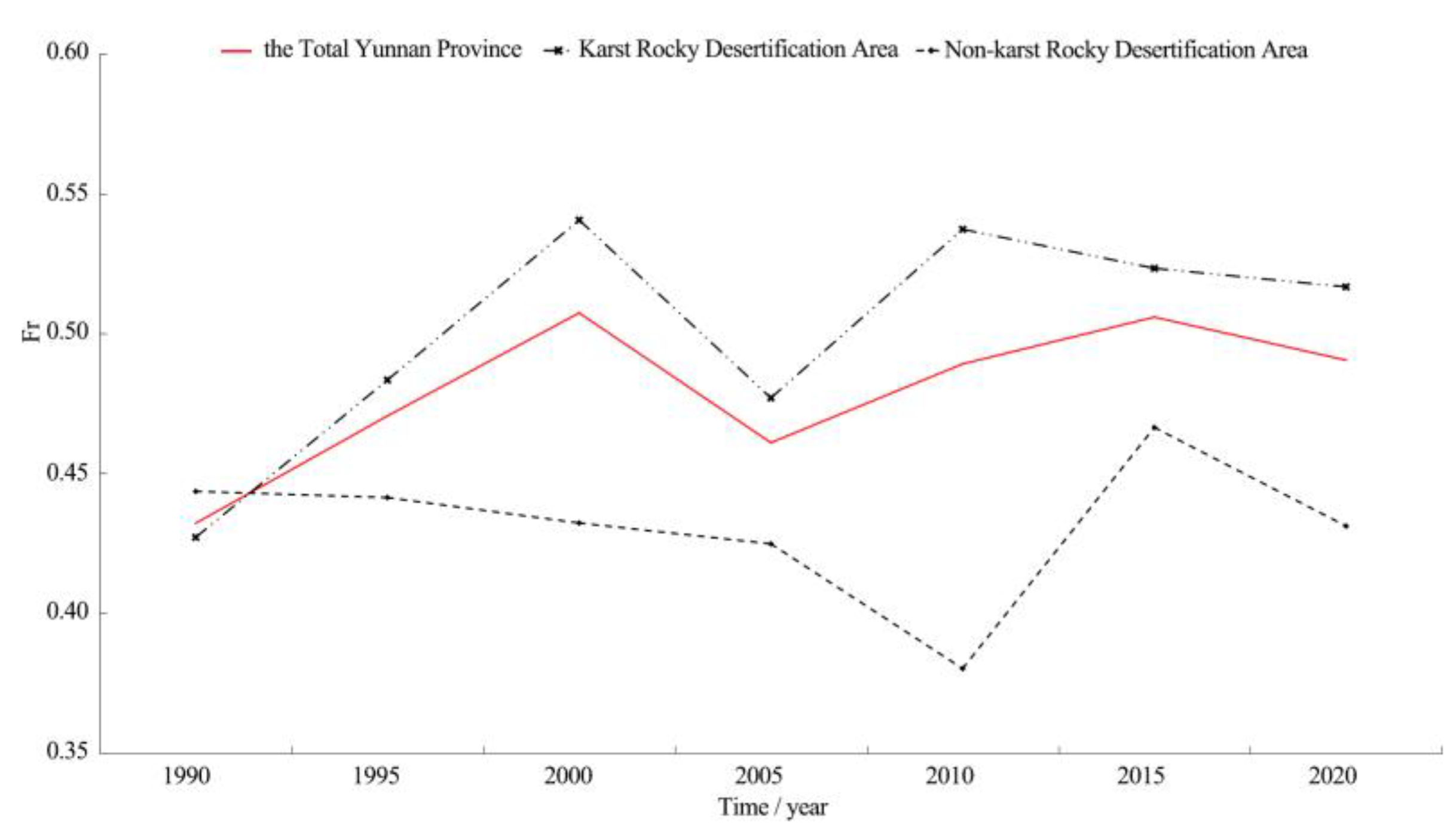
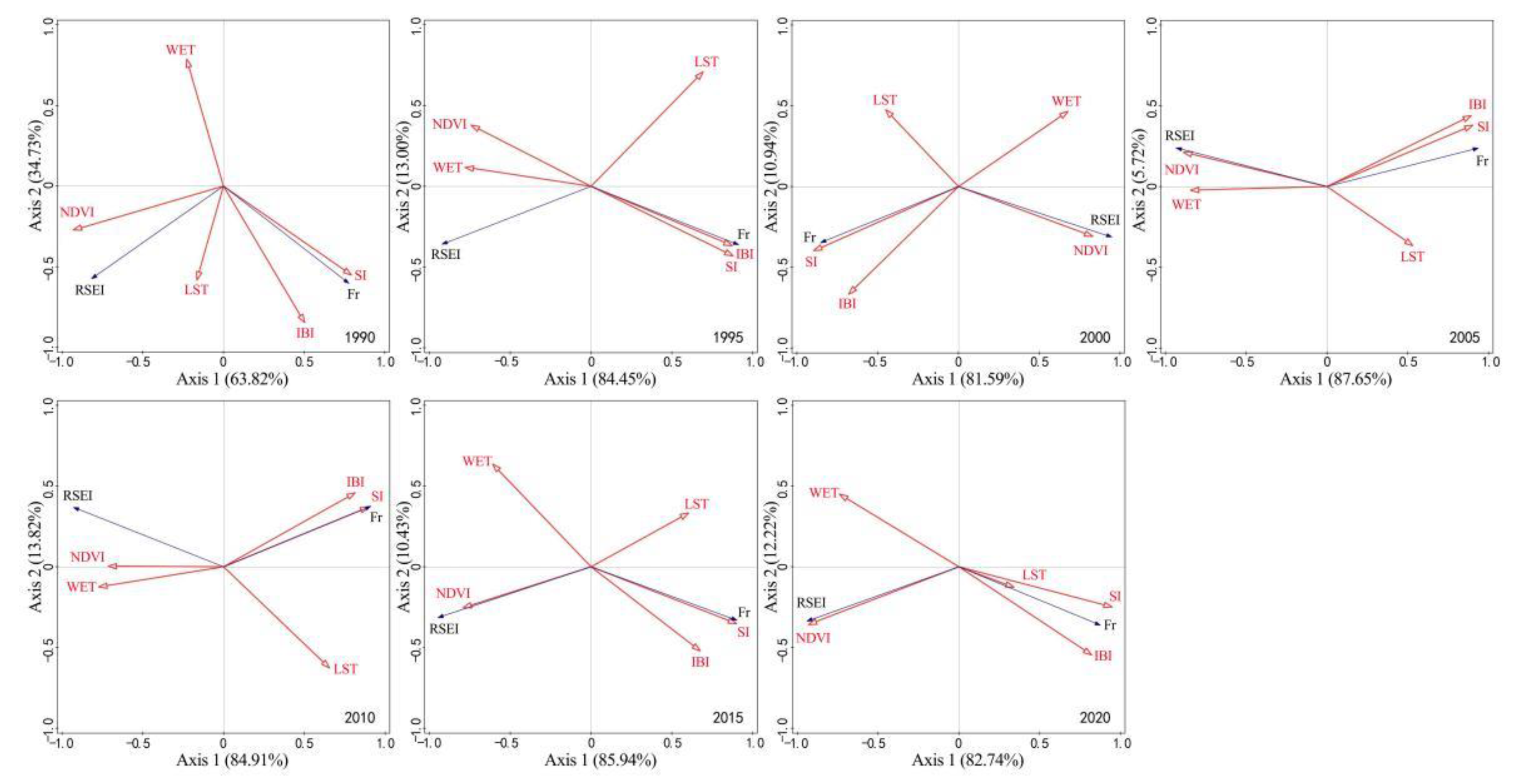
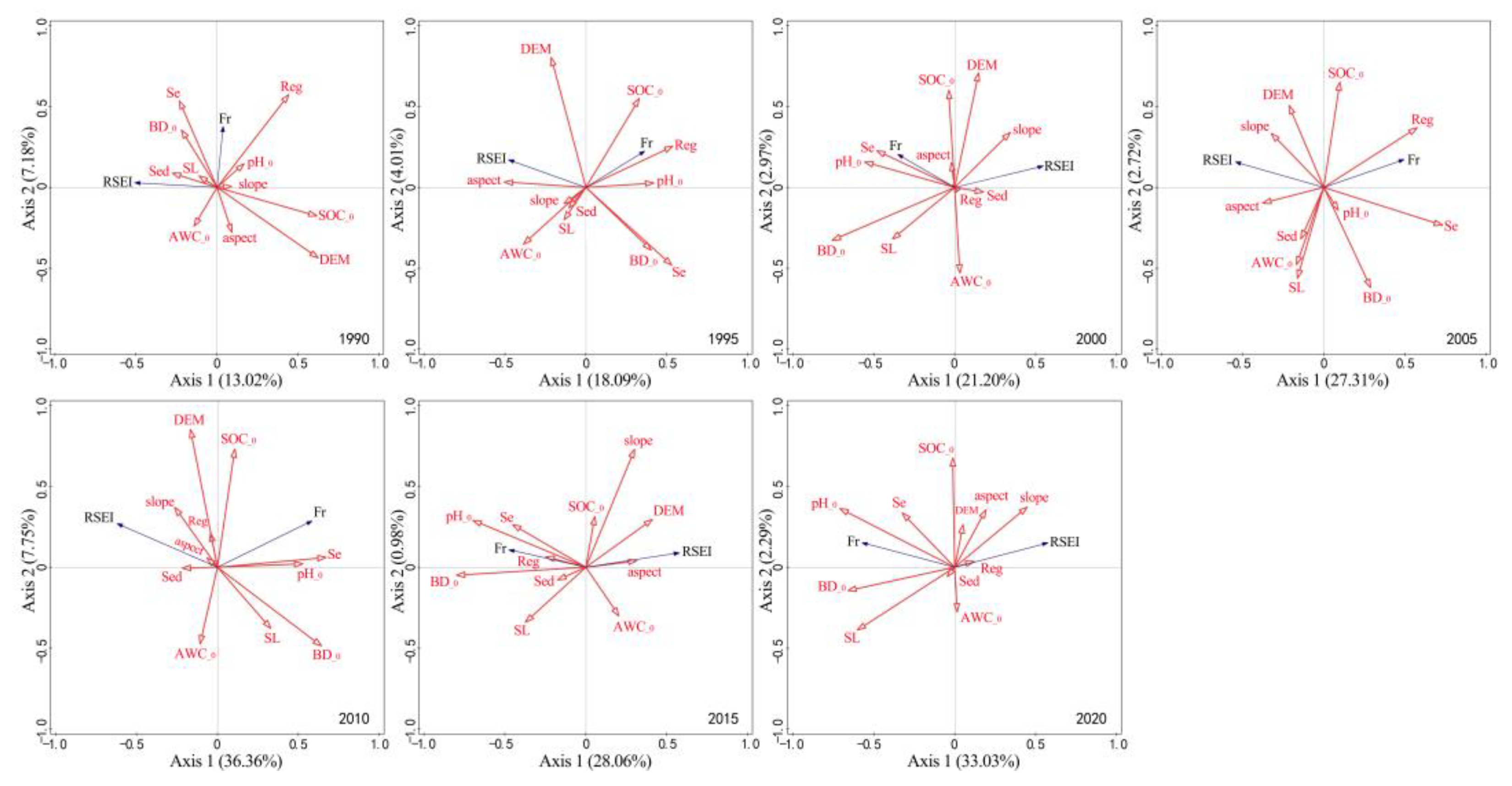
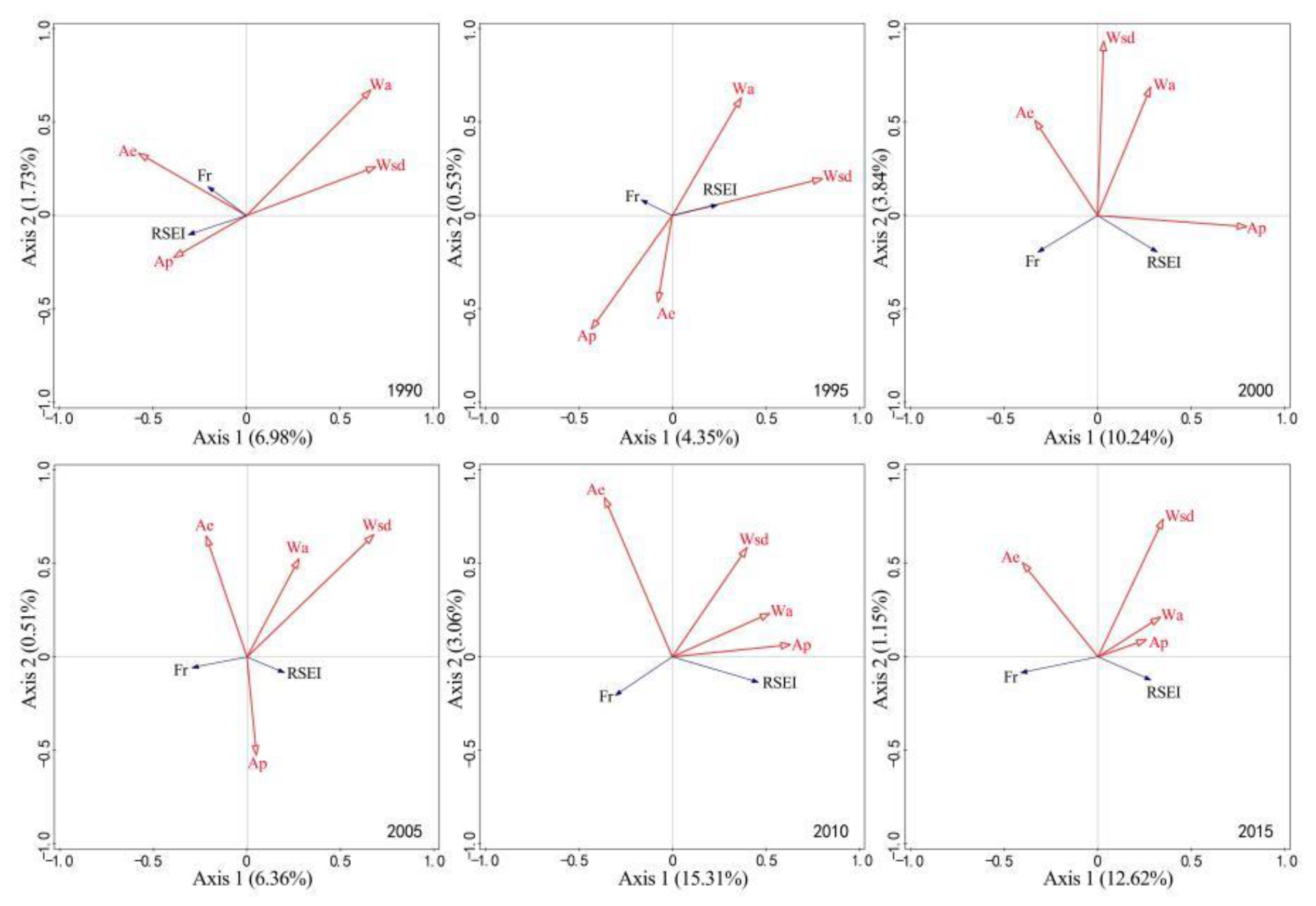
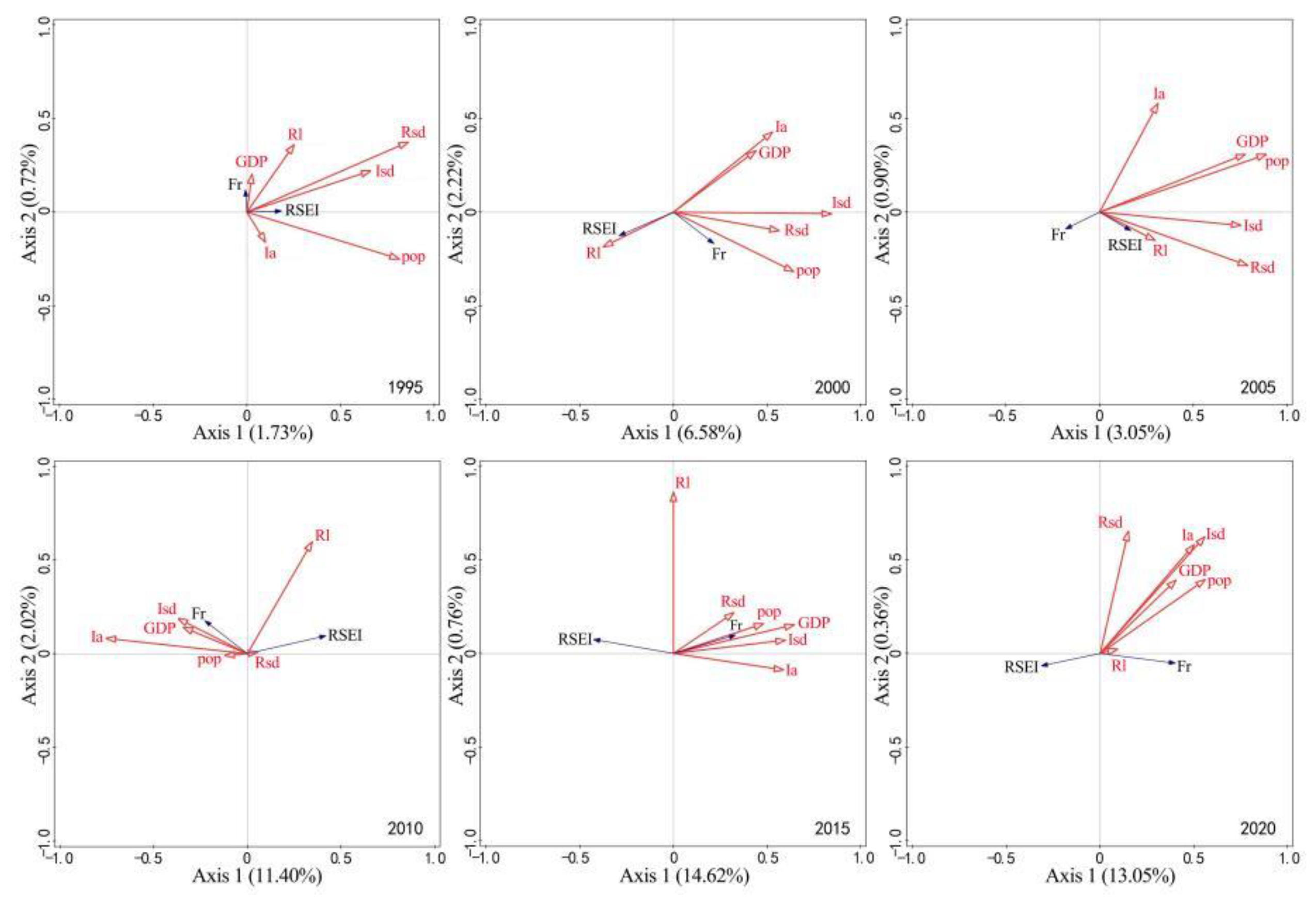
| Data Type | Data Sources | Basic Information |
|---|---|---|
| Landsat images TM/OLI | Geo-spatial cloud | Spatial resolution of 30 m |
| Digital elevation GDEMV2 | Geo-spatial cloud | Spatial resolution of 30 m, indicators include elevation, slope gradient, slope aspect |
| Soil texture gridded data | Hengl and MacMillan, 2019 [29] | Spatial resolution of 250 m, soil surface indicators include pH value, soil bulk density, soil available water content, soil organic carbon |
| A gridded global dataset of soil, intact regolith, and sedimentary deposit thicknesses | The U.S. Department of Energy’s (DOE) Oak Ridge National Laboratory (ORNL) [30] | Spatial resolution of 30 arcsec, indicators include soil, regolith, and sedimentary deposit |
| Spatial distribution data of soil erosion in China | Resource and Environment Science Data Center (RESDC), China Academy of Sciences (CAS) | Spatial resolution of 1 km |
| A dataset of China 30 m resolution actual evapotranspiration | Bintao Liu’s research team, Institute of Mountain Hazards and Environment (IMHE), CAS | Spatial resolution of 30 m, unit of mm |
| A dataset of spatially interpolated annual precipitation in China since 1980 | RESDC, CAS | Spatial resolution of 1 km, unit of mm |
| Waterbody data | OpenStreetMap | Indicators include area (km2), surface density (km2/km2) |
| Spatialization approach to 1 km grid population | RESDC, CAS | Spatial resolution of 1 km, unit of persons/km2 |
| Spatialization approach to 1 km grid GDP | RESDC, CAS | Spatial resolution of 1 km, unit of 10,000 RMB/km2 |
| Road data | OpenStreetMap | Indicators include length (km), surface density (km2/km2) |
| GISD30 dataset (global 30 m impervious surface dynamic) from 1985 to 2020 | Liangyun Liu’s research team, CAS [31] | Spatial resolution of 30 m, indicators include area (km2), surface density (km2/km2) |
| Ecological Quality Grading | 1990 | 1995 | 2000 | 2005 | 2010 | 2015 | 2020 | |||||||
|---|---|---|---|---|---|---|---|---|---|---|---|---|---|---|
| Area/km2 | Percentage | Area/km2 | Percentage | Area/km2 | Percentage | Area/km2 | Percentage | Area/km2 | Percentage | Area/km2 | Percentage | Area/km2 | Percentage | |
| 1 (RSEI ≤ 0.2) | 73.95 | 0.03% | 2.59 | 0.00% | 59.01 | 0.02% | 35.34 | 0.01% | 2884.27 | 1.08% | 366.73 | 0.14% | 1899.21 | 0.71% |
| 2 (0.4 ≥ RSEI > 0.2) | 376.12 | 0.14% | 58.22 | 0.02% | 10,952.22 | 4.11% | 149.64 | 0.06% | 102,920.89 | 38.60% | 1432.21 | 0.54% | 1869.48 | 0.70% |
| 3 (0.6 ≥ RSEI > 0.4) | 11,834.39 | 4.44% | 89,928.48 | 33.74% | 171,453.79 | 64.31% | 52,405.77 | 19.66% | 137,727.99 | 51.66% | 110,170.20 | 41.32% | 30,611.90 | 11.48% |
| 4 (0.8 ≥ RSEI > 0.6) | 95,999.08 | 36.01% | 176,517.59 | 66.23% | 83,748.57 | 31.41% | 213,379.71 | 80.03% | 22,271.61 | 8.35% | 148,742.25 | 55.79% | 114,324.74 | 42.88% |
| 5 (RSEI > 0.8) | 158,336.15 | 59.39% | 33.16 | 0.01% | 405.87 | 0.15% | 649.26 | 0.24% | 816.15 | 0.31% | 5909.20 | 2.22% | 117,915.04 | 44.23% |
| Rocky Desertification Degree | 1990 | 1995 | 2000 | 2005 | 2010 | 2015 | 2020 | |||||||
|---|---|---|---|---|---|---|---|---|---|---|---|---|---|---|
| Area/km2 | Percentage | Area/km2 | Percentage | Area/km2 | Percentage | Area/km2 | Percentage | Area/km2 | Percentage | Area/km2 | Percentage | Area/km2 | Percentage | |
| 1(Fr ≤ 20%) | 61,862.95 | 23.20% | 53,900.32 | 20.22% | 49,976.78 | 18.74% | 62,861.94 | 23.58% | 51,503.26 | 19.32% | 49,346.78 | 18.51% | 42,318.53 | 15.87% |
| 2(20% < Fr ≤ 30%) | 38,650.57 | 14.50% | 29,775.82 | 11.17% | 20,812.68 | 7.81% | 28,436.86 | 10.67% | 23,380.62 | 8.77% | 25,367.50 | 9.51% | 33,609.45 | 12.61% |
| 3(30% < Fr ≤ 50%) | 74,597.15 | 27.98% | 59,438.56 | 22.30% | 46,427.35 | 17.41% | 52,561.97 | 19.71% | 45,428.02 | 17.04% | 50,992.26 | 19.13% | 58,120.15 | 21.80% |
| 4(50% < Fr ≤ 70%) | 40,413.82 | 15.16% | 52,417.93 | 19.67% | 52,560.88 | 19.71% | 49,122.37 | 18.42% | 49,095.68 | 18.41% | 52,774.28 | 19.79% | 47,791.75 | 17.93% |
| 5(70% < Fr ≤ 90%) | 26,646.83 | 9.99% | 41,073.59 | 15.41% | 55,073.82 | 20.66% | 42,599.57 | 15.98% | 54,267.71 | 20.35% | 51,908.41 | 19.47% | 49,498.93 | 18.57% |
| 6(Fr > 90%) | 24,447.10 | 9.17% | 29,933.20 | 11.23% | 41,767.17 | 15.67% | 31,036.02 | 11.64% | 42,945.04 | 16.11% | 36,229.18 | 13.59% | 35,247.27 | 13.22% |
Publisher’s Note: MDPI stays neutral with regard to jurisdictional claims in published maps and institutional affiliations. |
© 2022 by the authors. Licensee MDPI, Basel, Switzerland. This article is an open access article distributed under the terms and conditions of the Creative Commons Attribution (CC BY) license (https://creativecommons.org/licenses/by/4.0/).
Share and Cite
Zhang, S.; Wang, Y.; Wang, X.; Wu, Y.; Li, C.; Zhang, C.; Yin, Y. Ecological Quality Evolution and Its Driving Factors in Yunnan Karst Rocky Desertification Areas. Int. J. Environ. Res. Public Health 2022, 19, 16904. https://doi.org/10.3390/ijerph192416904
Zhang S, Wang Y, Wang X, Wu Y, Li C, Zhang C, Yin Y. Ecological Quality Evolution and Its Driving Factors in Yunnan Karst Rocky Desertification Areas. International Journal of Environmental Research and Public Health. 2022; 19(24):16904. https://doi.org/10.3390/ijerph192416904
Chicago/Turabian StyleZhang, Shiwen, Yan Wang, Xuehua Wang, Yang Wu, Chengrong Li, Chao Zhang, and Yuhang Yin. 2022. "Ecological Quality Evolution and Its Driving Factors in Yunnan Karst Rocky Desertification Areas" International Journal of Environmental Research and Public Health 19, no. 24: 16904. https://doi.org/10.3390/ijerph192416904
APA StyleZhang, S., Wang, Y., Wang, X., Wu, Y., Li, C., Zhang, C., & Yin, Y. (2022). Ecological Quality Evolution and Its Driving Factors in Yunnan Karst Rocky Desertification Areas. International Journal of Environmental Research and Public Health, 19(24), 16904. https://doi.org/10.3390/ijerph192416904







